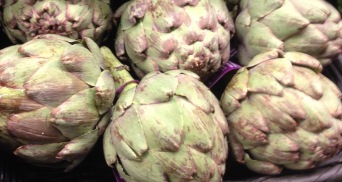What are Prebiotics?
No, that’s not a typo. Last time we discussed probiotics. Now our focus is prebiotics.
- Prebiotics make probiotics better.
- They feed and strengthen your gut bacteria.
- They also promote enzyme activity which is important for digestion, helping cells grow and various chemical reactions throughout the body.
They are non-digestible fibers of food that enhance the growth and activity of friendly bacteria.
Other nutrients besides fiber encourage the growth of probiotic bacteria as well. They are antioxidants and certain proteins and fats. All this is lumped together as prebiotics.
Some prebiotics feed good bactria, others slow down the bacteria that compete with them.
Synbiotics
The combination of both probiotics and prebiotics together in a food is called Synbiotics. They work together. They are found mostly in fermented foods such as sauerkraut, sour cream, yogurt, some cheeses, kimchi and kefir.
Foods That Contain Prebiotics
- pectin– in unpeeled fruits such as apples, pears, plums and oranges
- fiber– if you are already eating a high fiber diet, you are likely getting prebiotics. Only soluble fiber is prebiotic, not insoluble fiber. This is the kind that absorbs water and forms a gel. A good form of fiber is psyllium husk. Fiber helps probiotics grow. Other sources include oats, barley, rice bran, unpeeled fruits and vegetables. Increase your fiber gradually so your microflora can catch up.
- fermented foods (not pickled)- uses salt, not vinegar
- resistant starches acts as a prebiotic food because they behave more like fiber than starch. Examples are oats, lentils, green peas, green bananas and white beans.
- fruits and vegetables– berries, garlic, flaxseed, leeks, dandelion greens, spinach, kale, tomatoes, lentils, chickpeas, blackbeans.

- whole grains
Best source of prebiotics are:
- inulin– another complex carb that feeds your gut- found in vegetables, green bananas, wheat, onions, chicory root, artichokes, asparagus, leeks and jicama.
- FOS fructooligosaccharides- soluble fiber in vegetables with skins. They are carbs that aren’t digested well.
Metabiotics
According to Dr. Huffnagle, Metabiotics are metabolic byproducts made by probiotics that have healthy components. These are bacterial wastes that are good for us.
When probiotics consume soluble fiber, they produce short chain fatty acids as byproducts. These slow the growth of competing microbes. They nourish the cells of the intestinal wall keeping it healthy. They help limit inflammatory responses. In short, they help keep your gut healthy.
Phenols
Foods rich in phenols are full of antioxidants and also support  probiotics. They act like prebiotics increasing the good bacteria and inhibiting the bad. Foods rich in polyphenols are dark chocolate, black and green tea (not herbal or instant), berries, coffee, apples, red wine, flaxseed meal, cherries, certain herbs and spices and olives to name a few.
probiotics. They act like prebiotics increasing the good bacteria and inhibiting the bad. Foods rich in polyphenols are dark chocolate, black and green tea (not herbal or instant), berries, coffee, apples, red wine, flaxseed meal, cherries, certain herbs and spices and olives to name a few.
So eat your probiotic, prebiotics and polyphenols and make your gut happier.
“A brother offended is harder to win than a strong city, And contentions are like the bars of a castle.” Prov 18:19
Sources


Great info!! Thank you!
LikeLike
Thanks! See you next week!
LikeLike